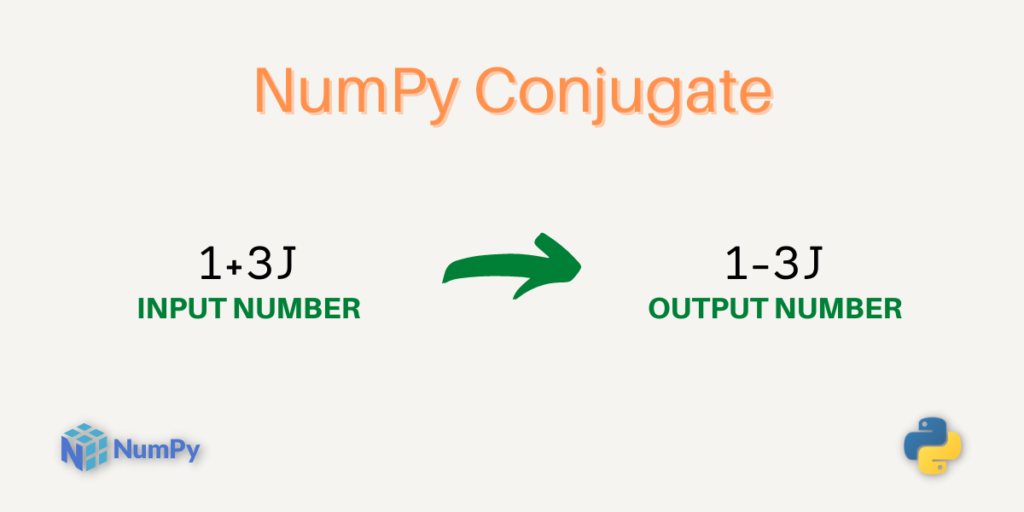Hey everyone, welcome to another NumPy mathematical functions tutorial. In this tutorial, we will understand the NumPy conj function in detail.
The conjugate of a complex number is obtained by simply changing the sign of the imaginary part.
For example, the conjugate of a complex number 10-8j is 10+8j. We can obtain the conjugate of a complex number using the numpy.conj() function.
So, let’s get started.
Also read: NumPy fmax – Element-wise maximum of array elements
About NumPy conj
NumPy conj is a mathematical function of the numpy library that calculates the complex conjugate of the input complex numbers.
Syntax
By definition, it sounds simple right? Now, let us look at the syntax of the function.
numpy.conj(input)
Here, the input can be a single complex number as well as a NumPy array of complex numbers.
Working with NumPy conj
Now, let’s do some programming in python.
NumPy conj of a single complex number
import numpy as np
# Complex Conjugate of a Complex number with real and imaginary parts
print("The complex conjugate of 1+6j is:",np.conj(1+6j))
print("The complex conjugate of 1-6j is:",np.conj(1-6j))
# Complex Conjugate of a Complex number with only imaginary part
print("The complex conjugate of 0+6j is:",np.conj(0+6j))
print("The complex conjugate of 0-6j is:",np.conj(0-6j))
# Complex Conjugate of a Complex number with only real part
print("The complex conjugate of 1 is:",np.conj(1))
print("The complex conjugate of -1 is:",np.conj(-1))
Output
The complex conjugate of 1+6j is: (1-6j)
The complex conjugate of 1-6j is: (1+6j)
The complex conjugate of 0+6j is: -6j
The complex conjugate of 0-6j is: 6j
The complex conjugate of 1 is: 1
The complex conjugate of -1 is: -1
In the above snippet, the NumPy library is imported using the import statement and the function np.conj() is used to calculate the complex conjugate of the input complex number.
Let’s understand how the values are calculated.
For complex number 1+6j, the conjugate is obtained by changing the sign of the imaginary part and hence the output is 1-6j.
For complex number 1, the conjugate will be the same as the input complex number. This is because the number 1 can be written as 1+0j, where the imaginary part is 0, hence the output is the same as the input complex number.
Now, let us pass a NumPy array of complex numbers and calculate the complex conjugate.
NumPy conj of a NumPy array of complex numbers
import numpy as np
a = np.array((1+3j , 0+6j , 5-4j))
b = np.conj(a)
print("Input Array:\n",a)
print("Output Array:\n",b)
Output
Input Array:
[1.+3.j 0.+6.j 5.-4.j]
Output Array:
[1.-3.j 0.-6.j 5.+4.j]
In the above snippet, a NumPy array of complex numbers is created using the np.array() which is stored in the variable a. The variable b stores the conjugate values of the input array which is also a NumPy array.
The np.conj() calculates the conjugate of each element of the input array.
In the next lines, we have used print statements to print the Input Array and Output Array.
NumPy conj of a NumPy array using the NumPy eye function
In this code snippet, we will create a NumPy array using the numpy.eye().
import numpy as np
a = np.eye(2) + 1j * np.eye(2)
b = np.conj(a)
print("Input Array:\n",a)
print("Conjugated Values:\n",b)
Output
Input Array:
[[1.+1.j 0.+0.j]
[0.+0.j 1.+1.j]]
Conjugated Values:
[[1.-1.j 0.-0.j]
[0.-0.j 1.-1.j]]
Let’s try to understand the above code snippet.
- In the first line, we import the NumPy library using the
importstatement. - The function
np.eye(2)creates a 2×2 array with the diagonal elements as 1 and other elements as 0. - Similarly, the expression
1j * np.eye(2)creates a 2×2 array with the diagonal elements as 1j and other elements as 0. - Then, the expression
np.eye(2)+1j * np.eye(2)adds the corresponding elements of the two arrays, which is stored in the variable a. - In the next line, we used the
np.conj()function to calculate the conjugated values.
That was all about using the NumPy conj function.
Summary
In this tutorial, you learned about the NumPy conj function along with practicing different types of examples. There is one more function numpy.conjugate() that works exactly the same way as the numpy.conj() function. Happy learning and keep coding.
